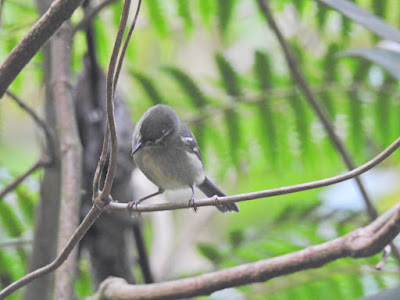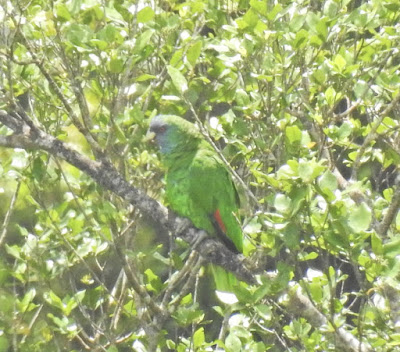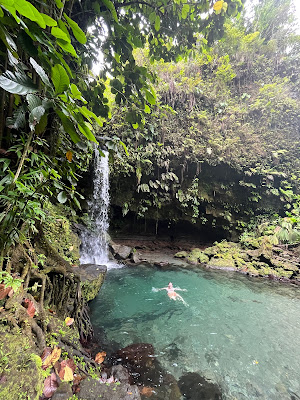I guess planning a wedding is difficult? I wouldn’t know, as Christina put in most of the effort. My job was to plan a relaxing honeymoon. Naturally, birds were going to be involved but they would not feature as big of a role as my trips usually do. A Caribbean island would be perfect. It would have beaches, relaxation, and enough endemic birds to occupy a few, but not many days. We were down to Dominica and St. Lucia, and Dominica won.
 |
| Scott's Head, the southern tip of Dominica |
Both islands are stunning and offer great birding. I typically would not stay a week on either island, so this was a perfect way to see some endemic birds while still having a honeymoon. Flights to Dominica were cheaper, more convenient, and there are two species of endemic parrot compared to one on St Lucia. Dominica is also called “the nature island” and was rumored to have more unspoiled nature.
 |
| Bananaquit |
With only two endemics and a few near endemics, we had 2 birding days planned. The two endemics pack a punch. The Imperial Parrot, locally known as the Sisserou, is a behemoth of a parrot that inhabits the high elevation rainforests and is critically endangered. The Red-necked Parrot, or Jaco, is a smaller parrot that can be found a little lower and is threatened. They are called Sisserou and Jaco after the maroon chiefs, Cicero and Jacko, that wore their feathers. The maroons were escaped slaves, who escaped up into the mountains to evade pursuers. The country is steep and largely inaccessible, which kept the maroons safe while also protecting swaths of forest that allow the Jacos and Sisserous to exist.
While obviously wanting every possible lifer on the island, there were only three targets. Both parrots and Blue-headed Hummingbird, which is a stunning bird that is only found in Dominica and Martinique. I hoped to avoid a possible future trip to Martinique by getting this bird, but alas I forgot it’s one endemic, the Martinique Oriole, so I will be going there eventually.
We first stayed at Rosalie Bay on the southeast corner of the island. The eco-resort offers everything you could need from a chilly river to black sand beaches. The driving to get there was…unnerving. You can’t really swim on the Atlantic side of the island but there are nesting sea turtles (which we unfortunately weren’t able to see). It was here that I started getting my first lifers in the gardens of the resort. Lesser Antillean Bullfinch was abundant here and all over the island and we also had Lesser Antillean Flycatcher. My personal favorite was getting good looks at lifer Purple-throated Carib. Our snorkeling day also earned Green-throated Carib and my first self found Brown Booby. Lesser Antillean Swifts were more common at high elevations while Black Swifts were common at sea level. Not bad for non-birding days.
 |
| Lesser Antillean Bullfinch |
I admittedly was really nervous to drive after our first day. The roads are narrow with many blind turns and the drivers are fast. You also drive on the left, which is not hard itself, but you have to adjust the way you look around for oncoming traffic. The main highway is fine, but we almost got ran off the road by a dump truck and a second car driving way too fast. I was scared to drive, but Emerald Pool, with its gorgeous waterfall, swimming hole, and some good birds was a 15 minute drive away. We drove there twice, once before our snorkeling day and on our last day Rosalie and it was immense for making me more comfortable on the roads.
 |
| Brown Trembler |
The forest itself is really dense. A quick walk through the forest yielded almost nothing except Pearly-eyed Thrasher and Plumbeous Warbler. Plumbeous Warbler isn’t a visually intriguing bird, but can only be found on Dominica and Guadeloupe. On our way back with little time to spare, I spent 15 minutes in the parking lot which was way more productive. Birds in general were way more abundant and I added the hard to find Forest Thrush and Brown Trembler, which has this bright yellow eye and cocked tail that makes it look way cooler than you would expect a solid brown bird to look.
 |
| Plumbeous Warbler |
The fireworks began the next day. We woke up later than expected, but the birding gods intended for this to happen. Not 5 minutes after arriving 3 Red-necked Parrots silently flew overhead. Second most important bird of the trip = seen. Walking down to the pool we added Caribbean Elaenia and got super close views of Plumbeous Warbler. It made the soak in the cold Emerald Pool, Christina’s favorite part of the trip, even more satisfying. To top it off we had Golden Frieds at breakfast to celebrate, which are delicious fried biscuits with cheese. The hike at Emerald Pool is so short and easy that it’s not even a hike. Get there as early as possible, we had the place to ourselves at 7 AM and it was magical. It’s also a UNESCO World Heritage site.
 |
| Red-necked Parrot from 1/4 mile away |
At this point I remembered how hard tropical birding can be with its dense forests, but we’ll get to that later.
 |
| There's a turd in Emerald Pool! |
After leaving Rosalie Bay we went up the road about an hour to Pagua Bay for the remainder of our trip. Still on the Atlantic side, it was closer to the airport and the main birding highlight, or so we thought. Pagua is awesome. The owners are great and the breezy afternoons by the pool were extremely pleasant (the Caribbean side is crazy hot and not breezy).
The only drawback is both Rosalie and Pagua are over an hour from the birding highlight: the Syndicate Trail, and the quickest route is a real pain to drive.
The Syndicate Trail is located high up in Morne Diablotin National Park. It’s the only reliable place to see Imperial Parrot, but it’s far from guaranteed. The trail offers 3 lookouts (most reports will say 2 but it’s really 3) that overlooks a hillside and deep valley. Dense forest blankets the steep hills. It’s great habitat and there’s plenty of it on the island, there just aren’t roads to access it.
 |
| If only she was looking at an Imperial Parrot |
After an hour long drive that made poor Christina nauseous we started the 4 mile ascent up a steep, one lane road. This is after Christina got up at sunrise. What a champ, I hit the jackpot. While it sounds terrifying, the road is paved and sparsely traversed in the morning making this section of the drive not nearly as scary as one would think.
Once we got up there we were immediately greeted by squawking Red-necked Parrots. An extremely friendly Lesser Antillean Bullfinch flew into our car and made friends with Christina, who called him Burty. The trail is quite easy, it’s only about .75 miles and flat. Here is where the mistakes began. The trail is lollipop shaped. The signs will point you to the lookouts, which we followed. This takes you to the upper lookout with a jaw dropping view of the valley and peaks of the mountains. However, as we would learn it’s not the best lookout for Imperial Parrots. We would miss the main lookout as we did not know there were 3 lookouts, and we only found it as we ran past it in the downpour. They are best seen from the lower lookout about 1/4 mile away. Still, we spent our morning up here. Red-neckeds were common and Broad-winged Hawks soared overhead while I scoped the valley looking for this near grail level bird. I was quickly interrupted by an incredible view or Blue-headed Hummingbird. Happy but focused, I returned to my search. Patience would be key.
 |
| Blue-headed Hummingbird |
Nothing. No Imperial calling, no large parrot flying through the valley. An Antillean Crested Hummingbird tried to make up for the silence. It helped. Then the Dominican race of House Wren, which I bet becomes a new species soon, came out as well. Our patience was rewarded with rain that turned into a full on storm that soaked us. After 3 hours we had to call it quits. Christina could have complained but stayed positive. She’s amazing.
It was time to bring in the big guns.
Only one person could help us. His name, Dr. Birdy. That sounds like the perfect name of a superhero birder, which is fitting because that’s exactly what Dr. Birdy is. A 34 year veteran of the Dominica’s forestry department, Dr. Birdy now guides full time and is the authority on Dominica’s birds, especially Imperial Parrots, which he has traveled the world to present about at conferences. He has seen every bird recorded on Dominica.
 |
| Gray Kingbird |
I suspected seeing an Imperial Parrot would be harder than just getting to the right habitat and that I might not see one by myself. Like Princess Leia to Obi-Wan, I sent Dr. Birdy an email and enlisted his services.
We all know I don’t like hiring guides and that I like to find my own birds. But while I am enthusiastic and willing to suffer to find those birds, that isn’t always enough and it was time to face it that I am not skilled enough to see this bird on my own, especially in the tropics. (That doesn’t mean local guides aren’t awesome, it’s just a personal preference. Sometimes they’re necessary.)
Dr. Birdy exceeded all expectations. Besides being incredible company, the man is a walking encyclopedia. He knows spots to see every bird down to the bush. He can pick up bird calls mere mortals like me can’t even detect.
The day was sunny and perfect for birding. Before getting to the Syndicate Trail I added Lesser Antillean Saltator, Black-whiskered Vireo, and Scaly-breasted Thrasher. We had great looks of Purple-throated Carib and Red-legged Thrush (previously seen in Puerto Rico), too. But now we were at the Syndicate Trail and it was game time.
 |
| Purple-throated Carib |
Even with a Dr. Birdy-caliber guide, he estimated our chances were about 60% due to the time of year. He confirmed that luck is the most important factor, followed by time of year, with March being the best time. Still, if there was a calling or flying bird in the valley, he would find it.
While we waited we were entertained by fantastic views of Red-necked Parrots. We saw them flying all throughout the and got views of them perched out in the open and enhanced by a scope. I feel bad for the Red-neckeds. These are top tier parrots but are overshadowed by the incredible Imperials so they do not get the love they deserve.
 |
| Lesser Antillean Flycatcher |
We had to pack it up after 4 hours. No Imperial Parrot called or flew, although Dr. Birdy said there were definitely a few parrots in the valley. I jokingly told Dr. Birdy he was just trying to get repeat business by having us miss on it, but that was clearly not true. He worked really hard to get us on the bird, but when your only real shot is a single valley with a few lookout points, all you can do is look, listen, and hope that it’s your lucky day. Some eBird checklists showed people waited as long as 13 hours to hear one calling, forcing them to return the next day for a fleeting glimpse. Christina would have done that for me, but being our honeymoon and the discomfort of driving in Dominica at night, we had to take the L.
 |
| It's easy to see how any parrot can get lost in the forest |
This is the moment in Dr. Birdy’s superhero story where the villain wins the battle and all hope appears lost, although Dr. Birdy will win the war of getting more people on the Imperial Parrot and increasing awareness of its kickassness. It’s all part of the story, and someone had to be part of the unlucky 40%.
Does it hurt to miss such an awesome bird? Absolutely. Considering our outdoor wedding was just few miles north of a horrible storm on the wedding day and 24 hours ahead of another bad storm that hit my parents house, I’m not too upset. If the cost of a perfect wedding day, great honeymoon, and no serious travel issues means that I have to trade seeing an Imperial Parrot then so be it, I’m making that trade every day.
Dipping on Imperial Parrot is also what makes birding such a beautiful hobby. Birding, and life in general, is not fun without some unknowns, struggles, and ultimately some heartbreaks. It makes the anticipation and success exhilarating and it makes the meticulous planning as much fun as it is.
Let’s not forget that Dominica is an amazing island with other stunning birds. Seeing a Red-necked Parrot and Blue-headed Hummingbird is why I want to go birding in new countries. The food was amazing, the people were super nice, and the views were breathtaking. Definitely make it out to Dominica and stay at Pagua Bay or Rosalie, but maybe stay in Portsmouth for a few days for quick access to Syndicate.
I’m already planning what I’m calling my “Caribbean Cleanup” to hit up a bunch of islands in the Caribbean to knock out some islands with a small number of endemics, and you better believe Dominica is on that list. I can’t wait to see Dr. Birdy, Imperial Parrots, and eat more Golden Frieds!
 |
| Rosalie Bay |






No comments:
Post a Comment